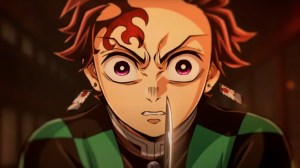The first of the Demon Slayer: Infinity Castle trilogy films has finally been released worldwide, marking the beginning of the all-out war between the Demon Slayers and the demons. The opening movie, titled “Part 1: Akaza”, sets the stage for the series’ main hero, Kamado Tanjiro, to rise to new heights before ultimately facing the main antagonist, Kibutsuji Muzan, in the final showdown. This first film builds momentum by having Tanjiro confront his greatest threat yet, but the groundwork for this clash was laid five years earlier when Tanjiro first encountered Upper Rank Three, Akaza, who killed Rengoku in a Demon Slayer movie released in 2020. With vengeance as the driving force of this matchup, the fight suggests that Tanjiro will overcome Akaza, fueled by his hatred.
Videos by ComicBook.com
When Akaza appears before Tanjiro and Giyu Tomioka, the Water Hashira, their battle initially stems from shared hatred toward the demon because of the devastation he has caused. In the fight, Tanjiro demonstrates strength on par with a Hashira, the result of his rigorous training under them. Yet, even this training proves insufficient against the formidable Akaza. Pushed to his limits, Tanjiro begins analyzing the battle and uncovers why Akaza can anticipate every attack. This realization leads him to achieve a state known as the “Selfless State” or Transparent World, where he can predict every move. The way Tanjiro develops this technique is portrayed brilliantly, but the most intriguing aspect is how this distinguishes him from other shonen protagonists and their clichéd tropes.
Demon Slayer‘s Main Hero Isn’t Crafted on Cliché Shonen Hero Tropes

The shonen genre in the anime and manga industry is undoubtedly one of the most popular and entertaining, even though it often follows a set formula. Typically, the narrative centers on the main hero pursuing his dream. However, one recurring trope in nearly every shonen series is the late-series revelation that the hero was destined for this path all along. While not inherently problematic, this trope implies that achieving great dreams requires destiny. Many examples exist, with one of the most famous being Monkey D. Luffy from One Piece, who also follows this pattern.
Before the time skip, Luffy was crafted as a character with a quirky power and an unpredictable journey, making him amusing and distinctive. Yet, he, too, eventually fell into the destined-hero trope. By acquiring the legendary fruit, which chooses its users, Luffy is revealed to be walking the path of liberation. While many classic shonen series shape their protagonists in this way, Demon Slayer Infinity Castle’s first movie elevates Tanjiro’s strength differently. Instead of being born with a unique ability, Tanjiro rises to face his greatest threat through techniques passed down and honed across generations.
When Tanjiro contemplates how to overcome Akaza and catch him off guard, he recalls a conversation with Inosuke that helps him realize Akaza relies on sensing fighting spirit and bloodlust to counter attacks. This sparks a memory of his father, who once killed a bear without showing malicious intent. From this, Tanjiro masters the so-called “Selfless State,” enabling him to fight without projecting hostility.
His father reveals that this technique was handed down through generations, tracing back to Tanjiro’s ancestor, Sumiyoshi, and his encounter with the man wearing Hanafuda earrings, as revealed in the first episode of Season 3. This confirms that the Kamado family inherited the Transparent World not by birthright but as a skill taught and refined over time. It also makes it clear that other Hashira may learn this state as well, preparing them to fight Muzan and the remaining Upper Rank demons.
Tanjiro’s Latest Power Upgrade Isn’t Exclusive to Him

Though Tanjiro was the first to be revealed with a mark on his head, the other Hashira soon follow and begin developing the same mark. After witnessing Tanjiro, they adapt this power, and it becomes clear that, after seeing his Selfless State, they, too, may achieve it. Even Akaza admits it is something he longed for, suggesting the technique can indeed be learned. Just as Tanjiro’s mark inspired the Hashira to awaken theirs, his latest achievement will also serve as a foundation for them to build upon.
This trope frames Tanjiro as a hero who propels others forward rather than standing out in a flashy, isolated way as many other shonen protagonists do. His role as a symbol of hope and a foundation for others is what makes him a truly unique modern shonen hero. Instead of reinforcing the usual shonen moral of being “born to achieve greatness,” Tanjiro’s journey teaches that mastery of skill and perseverance are what truly define an ideal hero.
What do you think? Leave a comment below and join the conversation now in the ComicBook Forum!
Want to stay up to date on the biggest geek entertainment news? Add us as a preferred source in Google – HERE.









